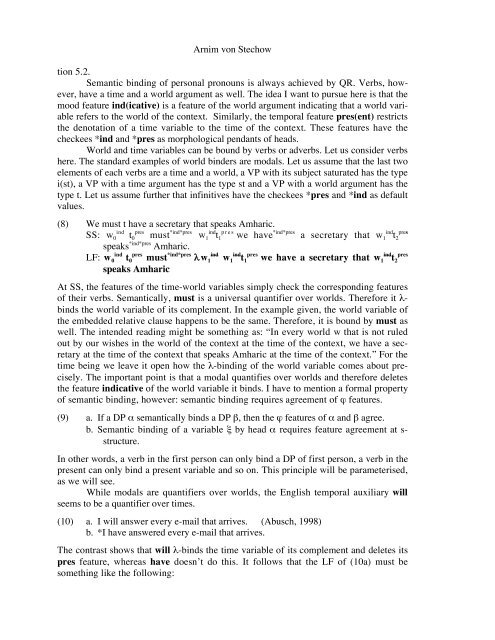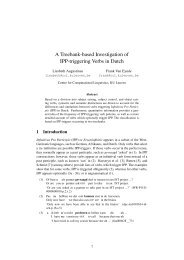Feature Deletion under Semantic Binding - Seminar für ...
Feature Deletion under Semantic Binding - Seminar für ...
Feature Deletion under Semantic Binding - Seminar für ...
Create successful ePaper yourself
Turn your PDF publications into a flip-book with our unique Google optimized e-Paper software.
Arnim von Stechow<br />
tion 5.2.<br />
<strong>Semantic</strong> binding of personal pronouns is always achieved by QR. Verbs, however,<br />
have a time and a world argument as well. The idea I want to pursue here is that the<br />
mood feature ind(icative) is a feature of the world argument indicating that a world variable<br />
refers to the world of the context. Similarly, the temporal feature pres(ent) restricts<br />
the denotation of a time variable to the time of the context. These features have the<br />
checkees *ind and *pres as morphological pendants of heads.<br />
World and time variables can be bound by verbs or adverbs. Let us consider verbs<br />
here. The standard examples of world binders are modals. Let us assume that the last two<br />
elements of each verbs are a time and a world, a VP with its subject saturated has the type<br />
i(st), a VP with a time argument has the type st and a VP with a world argument has the<br />
type t. Let us assume further that infinitives have the checkees *pres and *ind as default<br />
values.<br />
(8) We must t have a secretary that speaks Amharic.<br />
ind pres<br />
SS: w 0 t 0 must *ind*pres w ind pres<br />
1 t 1 we have *ind*pres a secretary that w ind pres<br />
1 t 2<br />
speaks *ind*pres Amharic.<br />
ind<br />
LF: w 0 t pres 0 must *ind*pres l w ind<br />
1 w ind pres<br />
1 t 1 we have a secretary that w ind pres<br />
1 t 2<br />
speaks Amharic<br />
At SS, the features of the time-world variables simply check the corresponding features<br />
of their verbs. <strong>Semantic</strong>ally, must is a universal quantifier over worlds. Therefore it l-<br />
binds the world variable of its complement. In the example given, the world variable of<br />
the embedded relative clause happens to be the same. Therefore, it is bound by must as<br />
well. The intended reading might be something as: “In every world w that is not ruled<br />
out by our wishes in the world of the context at the time of the context, we have a secretary<br />
at the time of the context that speaks Amharic at the time of the context.” For the<br />
time being we leave it open how the l-binding of the world variable comes about precisely.<br />
The important point is that a modal quantifies over worlds and therefore deletes<br />
the feature indicative of the world variable it binds. I have to mention a formal property<br />
of semantic binding, however: semantic binding requires agreement of j features.<br />
(9) a. If a DP a semantically binds a DP b, then the j features of a and b agree.<br />
b. <strong>Semantic</strong> binding of a variable x by head a requires feature agreement at s-<br />
structure.<br />
In other words, a verb in the first person can only bind a DP of first person, a verb in the<br />
present can only bind a present variable and so on. This principle will be parameterised,<br />
as we will see.<br />
While modals are quantifiers over worlds, the English temporal auxiliary will<br />
seems to be a quantifier over times.<br />
(10) a. I will answer every e-mail that arrives. (Abusch, 1998)<br />
b. *I have answered every e-mail that arrives.<br />
The contrast shows that will l-binds the time variable of its complement and deletes its<br />
pres feature, whereas have doesn’t do this. It follows that the LF of (10a) must be<br />
something like the following:

















